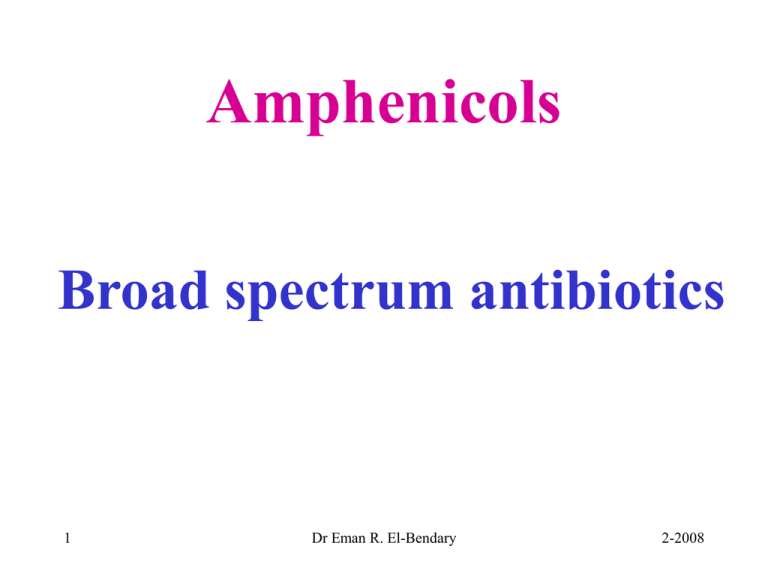Prodrugs of chloramphenicol
advertisement

Amphenicols Broad spectrum antibiotics 1 Dr Eman R. El-Bendary 2-2008 Mechanism of Action of Amphenicols • Amphenicols inhibit protein synthesis. • They bind to 50 S r-RNA and inhibit formation of peptide bond. 2 Dr Eman R. El-Bendary 2-2008 Chloramphenicol 1,3-propandiol p-Nitrophenyl group OH OH 3 1 (R) (R) 2 O O- NH N+ Acetamide group O Cl Cl 2,2-dichloro-N-((1R,2R)-1,3-dihydroxy-1-(4-nitrophenyl)propan-2-yl)acetamide D-(-)Threo isomer 3 Dr Eman R. El-Bendary 2-2008 Stereochemistry of chloramphenicol OH OH (R) (R) O OH HO O- NH O O Cl Cl OH (S) OH (S) HO O O- NH + N Cl 4 O- NH N+ Cl HO (S) N+ The active isomer Cl O (R) O (S) (R) O- NH N+ O Cl Dr Eman R. El-Bendary Cl 2-2008O Cl Structure Activity Relationship • Replacement of phenyl group by other aromatic systems or cyclic systems e.g. cyclohexyl, furyl, naphthyl, pyridyl or thienyl results in loss of activity. OH OH (R) • Replacement of NO2 by NH2, NHR, OH, SO2R, CN results in loss of activity. • Shifting of NO2 from para-position leads to loss of activity. • The propanediol moiety should be in D-(-) threo-isomer. Other isomers are inactive. • Replacement of OH, and extension or suppression of terminal CH2OH abolishes the activity. 5 O (R) O- NH N+ O Cl Dr Eman R. El-Bendary Cl 2-2008 Structure Activity Relationship OH • Replacement of nitro group by other electron withdrawing groups gives active compounds as CH3SO2 (Thiamphenicol) or CH3CO (Cetophenicol) OH (R) (R) O NH SO2CH3 Cl Cl Thiamphenicol OH OH (R) O (R) NH COCH3 6 Cl Dr Eman R. El-Bendary Cl Cetophenicol 2-2008 Metabolism of Chloramphenicol OH OH (R) COOH (R) OH OH O O OH O OH NH (R) OH (R) O O- NH2 (R) O- NH N+ O Cl (R) NH2 OH Cl Cl N+ OH OH O (R) (R) Cl C-3 glucuronide conjugate O O- NH N+ Major metabolite O OH OH (R) Cl OH OH Cl Chloramphenicol (R) O- O O N+ O- NH + N O O O 7 Cl Dr Eman R. El-Bendary 2-2008 Bacterial Resistance OH OCOCH3 (R) (R) Bacterial resistance to chloramphenicol arises from the ability of certain strains of bacteria to produce chloramphenicol acetyltransferase, an enzyme that acetylates OH at C-1 and C-3 of the propanol moiety to produce 1-acetoxy and 3-acetoxy derivatives, respectively, which are devoid of any activity. O O- NH N+ O Cl Cl 1-Acetoxy derivative OCOCH3 OH (R) O (R) O- NH N+ O Cl 8 Dr Eman R. El-Bendary Cl 3- Acetoxy derivative 2-2008 Latent forms of chloramphenicol (Prodrugs of chloramphenicol) Chloramphenicol palmitate • Since the drug is intensively bitter, this can be masked for use as a paediatric oral suspension by use of the C-3 palmitate, which has extremely low solubility. The ester is cleared in the duodenum to liberate the drug. O O N+ N+ O- O- HO HO Esterase Enzyme NH NH O O OH Cl O Cl (CH2)14COOH Cl Chloramphenicol Chloramphenicol palmitate 9 Cl O Dr Eman R. El-Bendary 2-2008 Latent forms of chloramphenicol (Prodrugs of chloramphenicol) Chloramphenicol hemisuccinate • Chloramphenicol has poor water solubility and, thus is largely overcomed by conversion to the 3-hemisuccinyl ester, which forms a water-soluble sodium salt suitable for parental preparation. This is cleaved in the body to produce active chloramphenicol. Because cleavage in muscles is too slow, this product is used intravenously rather than intramuscularly. Cl Cl O Cl Cl N+ O - N+ - O HN O O O HN Esterase Enzyme O OH O OH OH OH O Chloramphenicol Chloramphenicol succinate ester 10 Dr Eman R. El-Bendary 2-2008 Uses of Chloramphenicol • Despite of potential serious limitations, chloramphenicol is an excellent drug when used carefully. It is of special value for treatment of typhoid and parathyroid fevers, haemophilus infections, pneumococcal and meningococcal meningitis in beta lactam allergic patients. Safer antibiotics should be used whenever possible. 11 Dr Eman R. El-Bendary 2-2008 12 Dr Eman R. El-Bendary 2-2008











